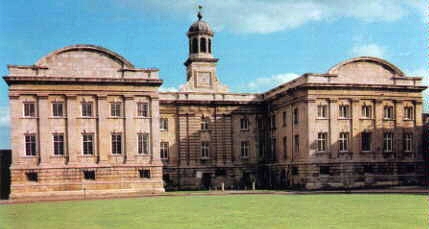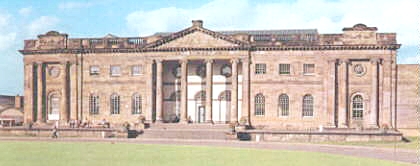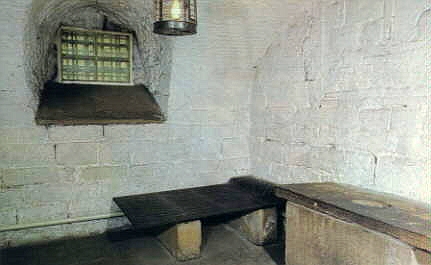At the end of the 17th century, it was
decided to build a new prison inside the bailey of York Castle
and work commenced on a new County
Gaol which opened in
1705, having taken four years to build. This building became known as the
Debtor's prison and was described by Daniel Defoe as, "the most stately
and complete prison of any in the Kingdom, if not in Europe, kept as neat
within side as it is noble without."
It is doubtful whether the inmates shared Defoe's enthusiasm, however!
A courthouse was added next door to it on one side in 1737 and the Female
Prison on the other side in 1783. All these fine buildings remain, indeed the
court still functions as York Crown Court. The two prisons closed at the end of
the 19th century. They were restored and converted into the Castle Museum
which opened in 1938 and which is still a really excellent visitor attraction.
|
The
Debtor's prison (male)

|
The
female prison

|
Executions at York.
From 1379 to 1800, executions were
carried out on Knavesmire (a large open space outside the city walls on the
road to Leeds) which now forms part of York racecourse. Between
January and August 1800, three men and three women were to suffer at York
Tyburn. The last of these took place on the 23rd of August 1800 when Elizabeth Johnson was hanged
for uttering forgery. The site of York
Tyburn, as the gallows was known, is marked by a plaque. As
at London's
Tyburn, the gallows was a triangular structure and had three beams supported by
three uprights. Prisoners were transported to it in horse drawn carts
sitting on their own coffins and with the noose around their necks. The gallows
was also nicknamed the "three-legged mare". The most infamous
criminal to be executed here was highwayman, Richard “Dick” Turpin. Turpin was
in fact a murderer and horse thief who became a legend in popular folklore. He
was hanged by Thomas Hadfield on Saturday,
April the 7th, 1739, together with another horse thief, John
Stead. Hadfield was a condemned prisoner
too and had, ironically, also been sentenced for highway robbery. As was the
custom at that time in York,
executions were carried out by a condemned prisoner who had been pardoned on
condition that he would act as hangman. York also boasted another
gallows up to 1676 which was situated at St.
Leonard’s Green Dyke, outside the Walls, at Walmgate Bar. It was
removed in June 1700, having been used for less than 100 executions.
Just as happened in London,
the gallows caused congestion at a major road junction and it was decided to
move it to the prison. Its relocation was explained by York's Herald newspaper on July 25th, 1800 as follows:
"Thus will be removed from one of the principal roads leading to the city
that disagreeable nuisance, the gallows; and thus will the inhabitants and
passengers be no longer interrupted, and their humanity hurt, by the leading of
unfortunate people to the place of execution."
A civic meeting was held and decided to invest in a new gallows, the cost of
which was a surprising £10.15s (£10.75).
The new structure was completed on the 8th of March 1801 and was first used for
the execution of cattle thief Samuel Lundy on the 11th of April 1801. It was set up at the back of the Castle in an
area bounded by the Castle
Mills Bridge
and the river Ouse. This continued to be the principal place of execution until
the mid 1820's. There was also another gallows in York, at the City Gaol
(opened in 1807 at Bishophill), and it was here on
the 12th of August 1809 that David Anderson was hanged for "uttering"
forged banknotes. It was only used once more in 1821 - see later.
Although York was an important city at the time, the
population was only 16,000 according to the 1801 census. However, York Castle
was the place of execution for persons convicted in all three Ridings of
Yorkshire up to 1856. Hangings were not an overly frequent event in York even in the early
1800's. There were three in 1802, five in 1803, two in 1804 and two in 1805. In
all, 153 men and seven women were hanged within the Castle precincts between
April 1801 and December 1896. Up to 1844, it was normal to hang all those
condemned at the end of each Assizes in groups, men and women together.
Murderers were typically hanged on Monday’s (up to 1830) and other criminals on
Saturday’s. Saturday became the execution day for all criminals from 1830 to
1862 as it allowed the for the biggest audience.
Probably the most famous female execution at
York was that
of "The Yorkshire Witch" on March the 20th, 1809.
Forty one year old Mary Bateman had been convicted of the murder by
poisoning in May 1808 of Rebecca Perigo. Mary had
been a criminal since childhood and in later years began duping people with her
self proclaimed supernatural powers. In 1806, William and Rebecca Perigo approached Mary asking for her help, as they
suspected that they had been put under a spell. Mary saw a great opportunity
here to bleed the Perigo's of their money before
killing them when they became suspicious of her activities. She didn’t manage
to kill William, however, as he wouldn’t eat the poison she had prepared for
them. Mary Bateman was hanged by William Curry and after execution, her body
was displayed in public and thousands paid to view it with the proceeds going
to charity. Strips of her skin were sold as charms to ward off evil. Click here for a
detailed account of this case.
1813 was to be the peak year for executions
at York with a
total of 20 men hanged there. The Luddites were trying to halt mechanisation in
the textile industries of Yorkshire and Lancashire by violent means as this was causing
widespread unemployment and destitution. Following an attempt to destroy
Cartwright's textile mill at Rawfold near Brighouse
in April 1812, over 100 men had been rounded up. Sixty four were charged with a variety of
offences and came before a special judicial commission at York Castle
at the beginning of January 1813. Twenty four of them were convicted and 17
sentenced to hang. The remainder were sentenced to transportation. The first of
the Luddite executions was carried out on Friday, the 8th of January when 3 men
suffered for the murder of mill owner, William Horsfall,
including the Luddite's leader in Yorkshire,
George Mellor. Just over a week later, on the 16th of January, the other 14
condemned Luddite's were executed for their parts in the raid on Cartwright's
mill in what was to be York's
biggest ever hanging. Five of them were
condemned for riot, 6 for burglary and 3 for robbery, having been convicted
under the Frame Breaking Act that came into force the previous year. They were
put to death in two groups by John Curry – seven at 11.00 a.m. and seven at 1.30 p.m. A "vast concourse" of people
assembled on St George’s Field to see this mass "launch into
eternity" as hangings were then known. Other Luddite executions took place
in Lancashire. A further three men were hanged
at York on the
3rd of April for fraud, forgery and highway robbery.
A new gallows was used from the mid 1820's -
similar in pattern to the one used to hang John Thurtell
at Hertford in 1824. (see
picture) This was brought out on the
occasion of an execution into the open area in front of the Debtor's prison and
between the Female prison and the court. After 1837, all executions at York were for murder. The
last man to suffer in public was Frederick Parker who was hanged together on the 4th of April 1868 for the
murder of Daniel Driscoll. On the
29th of May 1868, Parliament passed the Capital Punishment
(Amendment) Act ending public hangings.
It was to be 1874 before the next execution - that of William Jackson on
the 18th of August, for the murder of his sister.

 For private executions a new balcony style gallows
was set up at the end of one wing of the Debtor's prison. As can be seen from
the picture (right), this enabled a proper drop to be given and the execution
could be viewed by representatives of the press which was still allowed at this
time. This gallows was used for the last nine hangings at York between 1874 and 1896. The final
execution was that of August Carlson, for the murder of his wife, on Tuesday, the 22nd of December 1896.
The complete Victorian condemned cell (left) where Carlson spent his last days
can still be viewed. Note the iron bed on which a thin straw mattress would
have been placed. There was a fireplace provided in later years and a
rudimentary toilet.
For private executions a new balcony style gallows
was set up at the end of one wing of the Debtor's prison. As can be seen from
the picture (right), this enabled a proper drop to be given and the execution
could be viewed by representatives of the press which was still allowed at this
time. This gallows was used for the last nine hangings at York between 1874 and 1896. The final
execution was that of August Carlson, for the murder of his wife, on Tuesday, the 22nd of December 1896.
The complete Victorian condemned cell (left) where Carlson spent his last days
can still be viewed. Note the iron bed on which a thin straw mattress would
have been placed. There was a fireplace provided in later years and a
rudimentary toilet.
York's hangmen.
York
always had its own hangman in the 18th century, appointed from the inmate
population. Between 1802 and 1835, John (or William) Curry officiated there. He
was known as "Mutton Curry" and had twice been convicted of sheep
stealing, having had his death sentence commuted on each occasion. On the
second occasion, he was awaiting transportation when the post of hangman became
vacant and he accepted it, carrying out the hanging of three men on the 28th of August 1802 for
stealing sheep, cattle and from a dwelling house, respectively. In all, Curry
was responsible for at least 63 verifiable executions during his 33 year reign,
which ended with a triple execution on Monday, the 6th of April 1835, when Ursula Lofthouse, Joseph Healy and William Allott
were hanged for murder. As a convicted felon, Curry remained a prisoner himself
until 1814. He found his job stressful and took to drinking a lot of gin to
steel himself for the task. On April
14, 1821, he was called upon to perform two executions. First he
hanged highwayman Michael Shaw at York
Castle and then had to
walk across town to execute William Brown for burglary at the City Gaol. He was
somewhat drunk by the time he got there and while waiting on the platform for
the prisoner to appear, he began shaking the noose at spectators calling out to
them: "Some of you come up and I'll try it!" When Brown appeared,
Curry had to be assisted by a warder and one of the sheriff's officers.
"The executioner, in a bungling manner and with great difficulty (being in
a state of intoxication), placed the cap over the culprit's face and attempted
several times to place the rope round his neck, but was unable." "He
missed the unfortunate man's head with the noose every time that he tried. The
cap was each time removed from the malefactor's face, who stared wildly around
upon the spectators" the Times newspaper reported on April 24th. The crowd
were not amused by this and called out, "Hang him, hang Jack Ketch"
(the generic name for the hangman).
On September 1st, 1821,
Curry had to hang five men at one time. The execution was reported by The
Yorkshire Gazette as follows. "On Saturday last, a few minutes before 12 o'clock, the unfortunate men were
conducted from their cells to the fatal drop. "After
a short time spent in prayer they were launched into eternity. None of them
seemed to suffer much. "However, by an unaccountable neglect of the
executioner (Curry) in not keeping sufficiently clear of the drop when the bolt
was pulled out, he fell (into the trap) along with the malefactors."
Curry was succeeded by James Coates, who was also a prisoner at York, having been
sentenced to seven years transportation for larceny at the summer assizes of
1835. He executed Charles Batty in 1836 and Thomas Williams the following year,
both for attempted murder. He managed to escape from the castle around 1839 and
was never heard of again. Due to the unavailability of Calcraft, who was booked
for an execution at Stafford on the same day,
prisoner Nathaniel Howard took over the post in 1840 and hanged James Bradsley for the murder of his father on the 11th of April
of that year. He went on to hang a further 17 men between then and 1853 when he
bungled the hanging of murderer Henry Dobson so badly that, "when the drop
fell and the rope tightened around his neck, the condemned man struggled
violently" for which apparently Howard was dismissed. He was by this time
old and in poor health and died six days later. There were no executions at York between April 1853
and 1856 and a new executioner had to be found to hang 28 year old William Dove
for the murder of his wife on the
9th of August 1856, as Calcraft was again busy elsewhere. Thomas
Askern, who was in prison for debt at the time, was appointed to the role and
continued in office until 1868 performing eight executions at York including
the last one in public, that of Frederick Parker on the 4th of April 1868.
Executions had decreased markedly with the opening of Armley Gaol in Leeds, which became the place of many Yorkshire
hangings from 1864 to 1961. Askern died in Maltby at
the age of 62 on December
6th, 1878, ending the practice of York using their own hangman. William Marwood
officiated at the next five executions up to 1882. James Berry was used for the
execution of James Murphy on the
29th of November 1886. James Billington carried out the final three
hangings here, the last being that of August Carlson on the 22nd of December 1896. York Castle
did not have any executions in the 20th century.
Back to Contents page

 For private executions a new balcony style gallows
was set up at the end of one wing of the Debtor's prison. As can be seen from
the picture (right), this enabled a proper drop to be given and the execution
could be viewed by representatives of the press which was still allowed at this
time. This gallows was used for the last nine hangings at
For private executions a new balcony style gallows
was set up at the end of one wing of the Debtor's prison. As can be seen from
the picture (right), this enabled a proper drop to be given and the execution
could be viewed by representatives of the press which was still allowed at this
time. This gallows was used for the last nine hangings at 
